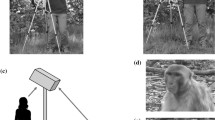Abstract
Squirrel monkeys (Saimiri sciureus) and capuchin monkeys (Cebus apella) were tested using an expectancy violation procedure to assess whether they use an actor’s gaze direction, signaled by congruent head and eye orientation, to predict subsequent behavior. The monkeys visually habituated to a repeated sequence in which the actor (a familiar human or a puppet) looked at an object and then picked it up, but they did not react strongly when the actor looked at an object but then picked up another object. Capuchin monkeys’ responses in the puppet condition were slightly more suggestive of expectancy. There was no differential responding to congruent versus incongruent look–touch sequences when familiarization trials were omitted. The weak findings contrast with a strongly positive result previously reported for tamarin monkeys. Additional evidence is required before concluding that behavior prediction based on gaze cues typifies primates; other approaches for studying how they process attention cues are indicated.




Similar content being viewed by others
References
Anderson JR (1998) Social stimuli and social rewards in primate learning and cognition. Behav Process 42:159–175
Anderson JR, Mitchell RW (1999) Macaques but not lemurs co-orient visually with humans. Folia Primatol 70:17–22
Anderson JR, Sallaberry P, Barbier H (1995) Use of experimenter-given cues during object-choice tasks by capuchin monkeys. Anim Behav 49:201–208
Anderson JR, Montant M, Schmitt D (1996) Rhesus monkeys fail to use gaze direction as an experimenter-given cue in an object-choice task. Behav Process 37:47–55
Anderson JR, Awazu S, Fujita K (2000) Can squirrel monkeys (Saimiri sciureus) learn self-control? A study using food array selection tests and reverse-reward contingency. J Exp Psychol Anim Behav Process 26:87–97
Anderson JR, Kuroshima H, Kuwahata H, Fujita K, Vick SJ (2001) Training squirrel monkeys (Saimiri sciureus) to deceive: acquisition and analysis of behavior toward cooperative and competitive trainers. J Comp Psychol 115:282–293
Call J, Hare B, Tomasello M (1998) Chimpanzee gaze following in an object-choice task. Anim Cogn 1:89–99
Cheney DM, Seyfarth RM (1990) How monkeys see the world. University of Chicago Press, Chicago, Ill.
Emery NJ, Lorincz EN, Perrett DI, Oram MW, Baker CI (1997) Gaze following and joint attention in rhesus monkeys (Macaca mulatta). J Comp Psychol 111:286–293
Fagot J, Deruelle C (2002) Perception of pictorial eye-gaze by baboons (Papio papio). J Exp Psychol Anim Behav Process 28:298–308
Ferrari PF, Kohler E, Fogassi L, Gallese V (2000) The ability to follow eye gaze and its emergence during development in macaque monkeys. Proc Natl Acad Sci USA 97:13997–14002
Fujita K, Kuroshima H, Masuda T (2002) Do tufted capuchin monkeys (Cebus apella) spontaeously deceive opponents? A preliminary analysis of an experimental food-competition contest between monkeys. Anim Cogn 5:19–25
Hare B, Call J, Agnetta B, Tomasello M (2000) Chimpanzees know what conspecifics do and do not see. Anim Behav 59:771–785
Hare B, Adessi E, Call J, Tomasello M, Visalberghi E (2003) Do capuchin monkeys, Cebus apella, know what conspecifics do and do not see? Anim Behav 65:131–142
Itakura S (1996) An exploratory study of gaze-monitoring in non-human primates. Jpn Psychol Res 38:174–180
Itakura S, Anderson JR (1996) Learning to use experimenter-given cues during object choice tasks by a capuchin monkey. Curr Psychol Cogn 15:103–112
Itakura S, Tanaka M (1998) Use of experimenter-given cues during object-choice tasks by chimpanzees (Pan troglodytes), an orangutan (Pongo pygmaeus), and human infants (Homo sapiens). J Comp Psychol 112:119–126
Johnson S, Slaughter V, Carey S (1998) Whose gaze will infants follow? The elicitation of gaze-following in 12-month-olds. Dev Sci 1:233–238
Karin-Darcy MR, Povinelli DJ (2002) Do chimpanzees know what each other see? A closer look. Int J Comp Psychol 15:21–54
Kuroshima H, Fujita K, Fuyuki A, Masuda T (2002) Understanding of the relationship between seeing and knowing by tufted capuchin monkeys (Cebus apella). Anim Cogn 5:41–48
Lorincz EN, Baker CI, Perrett DI (1999) Visual cues for attention following in rhesus monkeys. Curr Psychol Cogn 18:973–1003
Menzel CR (1980) Head-cocking and visual perception in primates. Anim Behav 28:151–159
Neiworth JJ, Burman MA, Basile BM, Lickteig MT (2002) Use of experimenter-given cues in visual co-orienting and in an object-choice task by a New world monkey species, cotton top tamarins (Saguinus oedipus). J Comp Psychol 116:3–11
Peignot P, Anderson JR (1999) Use of experimenter-given manual and facial cues by gorillas (Gorilla gorilla) in an object-choice task. J Comp Psychol 113:253–260
Povinelli DJ, Eddy TJ (1996a) What young chimpanzees know about seeing. Monogr Soc Res Child Dev 61:1–152
Povinelli DJ, Eddy TJ (1996b) Chimpanzees: joint visual attention. Psychol Sci 7:129–135
Povinelli DJ, Parks KA, Novak MA (1991) Do rhesus monkeys (Macaca mulatta) attribute knowledge and ignorance to others? J Comp Psychol 105:318–325
Povinelli DJ, Bierschwale DT, Cech CG (1999) Comprehension of seeing as a referential act in young children, but not chimpanzees. Br J Dev Psychol 17:37–60
Santos LR, Hauser MD (1999) How monkeys see the eyes: cotton-top tamarins’ reaction to changes in visual attention and action. Anim Cogn 2 131–139
Thomas RK, Walden EL (1985) The assessment of cognitive development in human and nonhuman primates. In: Bateson PPG, Klopfer PH (eds) Perspectives in ethology. Plenum, New York, pp 187–215
Tomasello M, Call J, Hare B (1998) Five primate species follow the gaze of conspecifics. Anim Behav 55:1063–1069
Tomasello M, Hare B, Fogelman T (2001) The ontogeny of gaze following in chimpanzees, Pan troglodytes, and rhesus macaques, Macaca mulatta. Anim Behav 61:335–343
Vick SJ, Anderson JR (2000) Learning and limits of use of eye gaze by capuchin monkeys (Cebus apella) in an object-choice task. J Comp Psychol 114:200–207
Vick SJ, Anderson JR (2003) Use of human visual attention cues by olive baboons (Papio anubis) in a competitive task. J Comp Psychol 117:209–216
Vick SJ, Bovet D, Anderson JR (2001) Gaze discrimination learning in olive baboons (Papio anubis). Anim Cogn 4:1–10
Acknowledgements
We acknowledge financial support from the Japanese Ministry of Education, Culture, Science, Sports, and Technology (MEXT) for Grant-in-Aid for Scientific Research No. 13410026 to K. Fujita, and 21st Century Center-of-Excellence Program D-2 to Kyoto University. The research described in this article complies with current laws on animal experiments in Japan.
Author information
Authors and Affiliations
Corresponding author
Rights and permissions
About this article
Cite this article
Anderson, J.R., Kuroshima, H., Kuwahata, H. et al. Do squirrel monkeys (Saimiri sciureus) and capuchin monkeys (Cebus apella) predict that looking leads to touching?. Anim Cogn 7, 185–192 (2004). https://doi.org/10.1007/s10071-004-0209-z
Received:
Revised:
Accepted:
Published:
Issue Date:
DOI: https://doi.org/10.1007/s10071-004-0209-z




